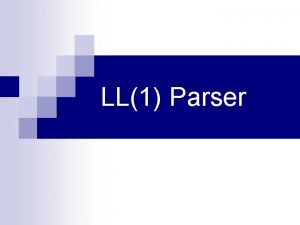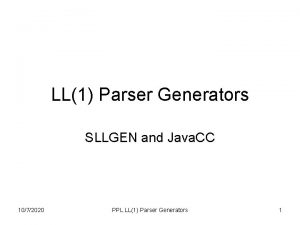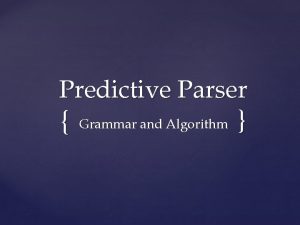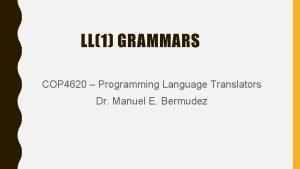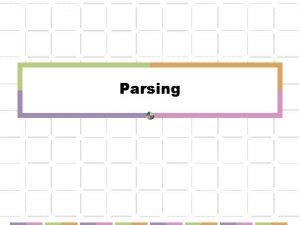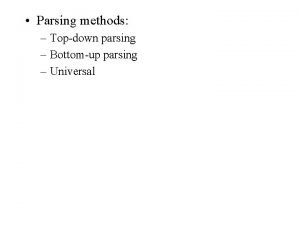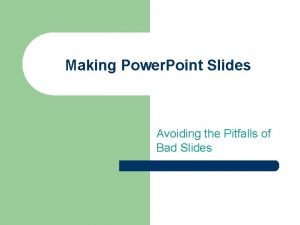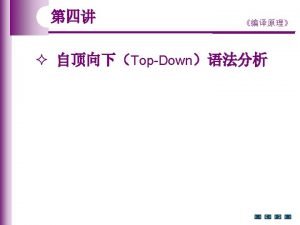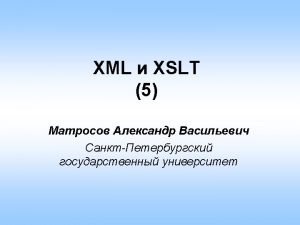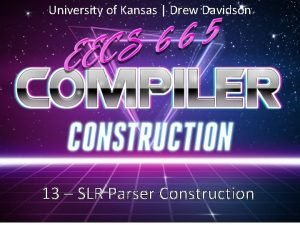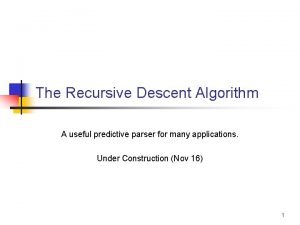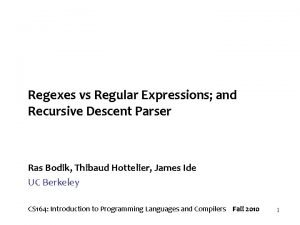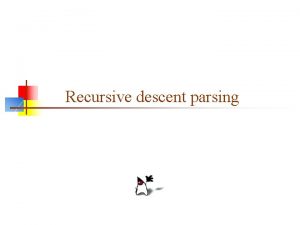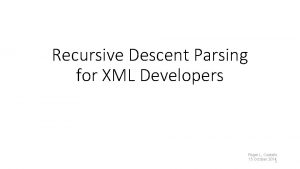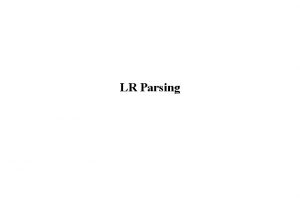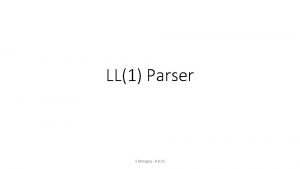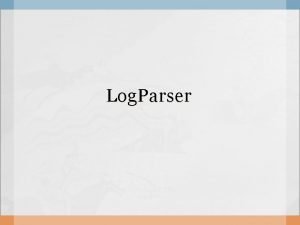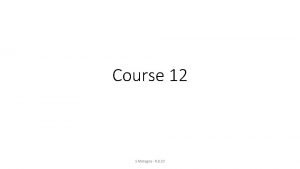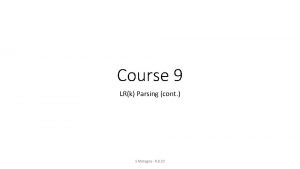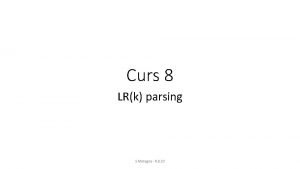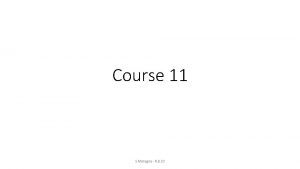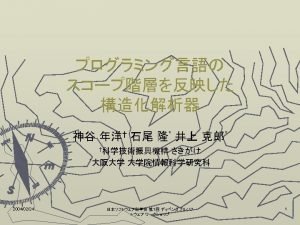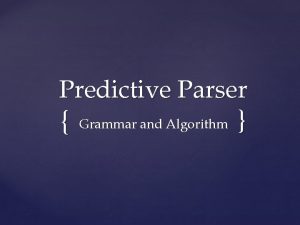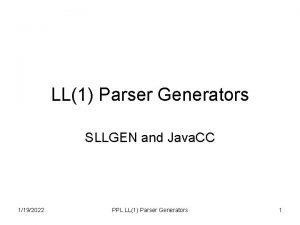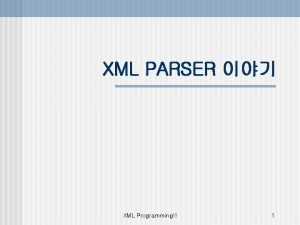LL1 Parser S Motogna FLCD Linear algorithm S
















- Slides: 16

LL(1) Parser S. Motogna - FL&CD

Linear algorithm S. Motogna - FL&CD

FIRSTk • ≈ first k terminal symbols that can be generated from �� FOLLOWk • ≈ next k symbols generated after/ following A S. Motogna - FL&CD

LL(k) Principle • L = left (sequence is read from left to right) • L = left (use leftmost derivation) • Prediction of length k ai+1…ai+k • In any moment of parsing, acțion is uniquely determinde by: • Closed part (a 1…ai) • Current symbol A • Prediction ai+1…ai+k (length k) S. Motogna - FL&CD

Definition • A cfg is LL(k) if for any 2 leftmost derivation we have: st st such that then S. Motogna - FL&CD

Theorem The necessary and sufficient condition for a grammar to be LL (k) is that for any pair of distinct productions of a nonterminal (A→ �� , A→�� , �� ≠�� ) the condition holds: * such that FIRSTk(���� ) ⋂ FIRSTk(���� )= �� , ∀�� astfel încât S => u. A�� Theorem: A grammar is LL(1) if and only if for any nonterminal A with productions A →�� , FIRST(�� 1| �� 2|. . . | �� n , FIRST(�� i) ∩ FIRST(�� j) = ∅ and if �� i⇒�� i) ∩ FOLLOW(A)= ∅, ∀i, j = 1, n, i≠j S. Motogna - FL&CD

LL(1) Parser • Prediction of length 1 • Steps: Executed 1 time 1) construct FIRST, FOLLOW 2) Construct LL(1) parse table 3) Analyse sequence based on moves between configurations S. Motogna - FL&CD

Step 2: Construct LL(1) parse table • Possible action depend on: • Current symbol ∈ N∪�� • Possible prediction ∈ �� • Add a special character “$” ( ∉ N∪�� ) – marking for “empty stack” = > table: • One line for each symbol ∈ N∪�� ∪{$} • One column for each symbol ∈ �� ∪{$} S. Motogna - FL&CD

Rules LL(1) table production in P with number i if production in P with number i (error) otherwise S. Motogna - FL&CD

Remark A grammar is LL(1) if the LL(1) parse table does NOT contain conflicts – there exists at most one value in each cell of the table M(A, a) S. Motogna - FL&CD

Step 3: Definire configurations and moves • INPUT: • Language grammar G = (N, �� , P, S) • LL(1) parse table • Sequence to be parsed w =a 1…an • OUTPUT: If (w ∈L(G)) then string of productions else error & location of error S. Motogna - FL&CD

LL(1) configurations Initial configuration: (w$, S$, �� ) (�� , �� ) where: • �� = input stack • �� = working stack • �� = output (result) Final configuration: ($, $, �� ) S. Motogna - FL&CD

Moves 1. Push – put in stack if (pop A and push symbols of �� ) 2. Pop – take off from stack (from both stacks) if 3. Accept 4. Error - otherwise S. Motogna - FL&CD

Algorithm LL(1) parsing • INPUT: § LL(1) table with NO conflicts; § G –grammar (productions) § Input sequence w = a 1 a 2. . . An • OUTPUT: § sequence accepted or not? § If yes then string of productions S. Motogna - FL&CD

Algorithm LL(1) parsing (cont) alfa : = w$; beta : = S$; pi : = ɛ; go : = true; while go do if M(head(beta), head(alfa))=(b, i) then pop(beta); push(beta, b); add(pi, i) else if M(head(beta), head(alfa))=pop then pop(beta); pop(alfa); else if M(head(beta), head(alfa))=acc then go: =false; s: =”acc”; else go: =false; s: =”err”; if s=”’acc”’ then end if write(”Sequence accepted”); end if write(pi) else end if end while write(” Sequence not accepted”) S. Motogna - FL&CD

Remarks 1) LL(1) parser provides location of the error 2) Grammars can be transformed to be LL(1) example: I -> if C then S | if C then S else S // is not LL(1) I -> if C then S T T -> ɛ | else S // is LL(1) S. Motogna - FL&CD
 Ll1
Ll1 Sllgen
Sllgen Predictive grammar
Predictive grammar Ll1
Ll1 Soa-ll1
Soa-ll1 Top down parsing vs bottom up
Top down parsing vs bottom up Soa-ll1
Soa-ll1 Ll1
Ll1 Diff between a* and ao*
Diff between a* and ao* Sweep line algorithm cp algorithm
Sweep line algorithm cp algorithm Msxsl.exe
Msxsl.exe Drew davidson ku
Drew davidson ku Eliminate left recursion calculator
Eliminate left recursion calculator Recursive descent parser
Recursive descent parser Recursive descent parsing
Recursive descent parsing Limitations of recursive descent parser
Limitations of recursive descent parser Lr parsers are attractive because
Lr parsers are attractive because
